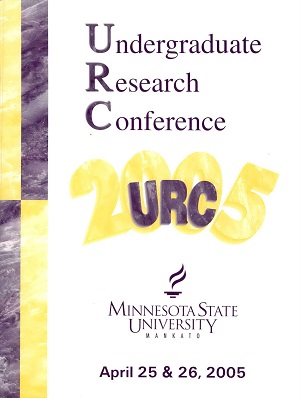Antimicrobial Resistance Patterns of Escherichia coli Isolates from Tributaries of the Minnesota River
Location
CSU 285
Start Date
25-4-2005 10:30 AM
End Date
25-4-2005 12:00 PM
Student's Major
Biological Sciences
Student's College
Science, Engineering and Technology
Mentor's Name
Timothy Secott
Mentor's Department
Biological Sciences
Mentor's College
Science, Engineering and Technology
Description
Environmental microorganisms that are resistant to antibiotics can transfer this property to pathogenic microorganisms, making infections caused by the latter more difficult to treat. The purpose of this project is to test Escherichia coli and related bacteria obtained from tributaries of the Minnesota River for susceptibility to commonly used antibiotics, thereby gaining a better understanding of the potential of bacteria isolated from local watersheds to serve as a reservoir for antimicrobial resistance. Escherichia coli and other members of the family Enterobacteriaceae recovered from water samples were tested for antimicrobial susceptibility using the Kirby Bauer disk diffusion method. To date, more than 70% of E. coli isolates were sensitive to amoxicillin, aztreonam, gentamicin, trimethoprim/sulfamethoxazole, and tetracycline; less than 50% were sensitive to ampicillin or cephalothin. More than 65% of other Enterobacteriaceae isolates were sensitive to aztreonam, gentamicin, trimethoprim/sulfamethoxazole, or tetracycline; less than 35% were sensitive to ampicillin, amoxicillin, or cephalothin. Forty-three percent (6/14) of E. coli isolates were resistant to two or more drugs, while 83% (5/6) of other Enterobacteriaceae isolates were multiply-resistant. These trends will be compared with regional resistance profiles for similar organisms isolated at regional veterinary and human clinical laboratories.
Antimicrobial Resistance Patterns of Escherichia coli Isolates from Tributaries of the Minnesota River
CSU 285
Environmental microorganisms that are resistant to antibiotics can transfer this property to pathogenic microorganisms, making infections caused by the latter more difficult to treat. The purpose of this project is to test Escherichia coli and related bacteria obtained from tributaries of the Minnesota River for susceptibility to commonly used antibiotics, thereby gaining a better understanding of the potential of bacteria isolated from local watersheds to serve as a reservoir for antimicrobial resistance. Escherichia coli and other members of the family Enterobacteriaceae recovered from water samples were tested for antimicrobial susceptibility using the Kirby Bauer disk diffusion method. To date, more than 70% of E. coli isolates were sensitive to amoxicillin, aztreonam, gentamicin, trimethoprim/sulfamethoxazole, and tetracycline; less than 50% were sensitive to ampicillin or cephalothin. More than 65% of other Enterobacteriaceae isolates were sensitive to aztreonam, gentamicin, trimethoprim/sulfamethoxazole, or tetracycline; less than 35% were sensitive to ampicillin, amoxicillin, or cephalothin. Forty-three percent (6/14) of E. coli isolates were resistant to two or more drugs, while 83% (5/6) of other Enterobacteriaceae isolates were multiply-resistant. These trends will be compared with regional resistance profiles for similar organisms isolated at regional veterinary and human clinical laboratories.
Recommended Citation
Klungseth, Lacey. "Antimicrobial Resistance Patterns of Escherichia coli Isolates from Tributaries of the Minnesota River." Undergraduate Research Symposium, Mankato, MN, April 25, 2005.
https://cornerstone.lib.mnsu.edu/urs/2005/oral-session-D/4



